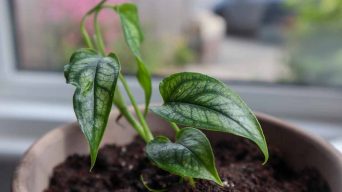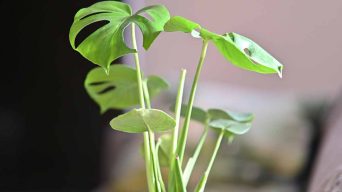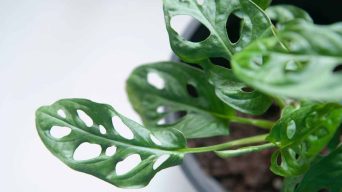Monstera plants cannot be propagated from a cutting without a node. This is because the nodes contain necessary structures for new growth, such as stems and leaves. Although it may be possible to keep the leaf fresh and help it form roots when placed in water, no new growth will emerge without the presence of a node.
Growing a Monstera plant from a cutting can be an exciting and rewarding experience.
But, if you’re like most people, you may have heard that it’s possible to propagate one without the presence of a node. Is this true?
Here we’ll explore the myths and truths about propagating Monstera without nodes – so you can better understand how to grow your Monstera plant from cuttings successfully!
Can You Propagate Monstera Without Node?
In the world of houseplants, the Monstera, the Swiss Cheese plant, is one of the most popular.
With its beautiful foliage and easy care requirements, it’s no wonder why so many people are drawn to this plant.
But what happens when you want to propagate your Monstera without a node? Is it even possible?
The Importance of Nodes
Nodes are essential for the successful propagation of any plant, including Monstera.
Nodes are small bumps or protrusions on stems that contain cells that can develop into new roots and shoots.
Without these nodes, it’s impossible for a Monstera cutting to form new growth and become an independent plant.
The Role of Nodes in Propagation
To understand why propagation without nodes isn’t feasible, we need to take a closer look at the role of nodes in propagation.
When cutting from an existing plant, the cutting must contain at least one node to grow new leaves and stems.
This is because nodes contain the structures necessary for new growth, such as root primordia (the beginnings of roots) and meristematic tissue (cells that can divide and differentiate into different tissue types).
Without these structures, the cutting cannot form new roots or shoots and will eventually die off.
Even if you could get a cutting without nodes to root in water or soil, it would never develop into an independent plant with stems or additional leaves.
Node vs. Non-Node Propagation
What happens if you try propagating a Monstera without a node? Unfortunately, nothing good!
A leafless stem cutting won’t be able to form any new roots or shoots since no cells can do so.
Even if you could get the Monstera cutting to root in water or soil, it would never develop into an independent plant with stems or additional leaves like those found on mature plants.
On the other hand, cuttings with at least one node have a much higher chance of success when propagated correctly.
When kept in water, these cuttings will start rooting within two weeks and should begin forming new leaves within four weeks after being potted up in the soil.
Propagating Monstera without nodes is not feasible due to their importance in forming new roots and shoots from cuttings taken from existing plants.
If you want your Monstera propagation efforts to succeed, ensure your cuttings always contain at least one node before planting them!
What Is a Node on a Monstera Plant?
A node is an area of growth on a plant, typically found between the petiole (the stem that connects the leaf to the main stem) and the stem itself.
On a Monstera plant, nodes are small bumps along the stem where new leaves, branches, twigs, and aerial roots can grow from.
Role of Nodes in Plant Growth
Nodes play an important role in plant growth because they are responsible for producing new stems, leaves, and aerial roots.
When these nodes are stimulated by light or other environmental factors, they will produce new shoots, eventually becoming part of the plant’s main structure.
This process is known as propagation, allowing plants to spread quickly and efficiently throughout their environment.
How to Identify a Node
Identifying nodes on a Monstera plant is relatively easy as they appear as small bumps along its stems or at branch intersections.
Depending on age, these bumps may have different colors; older nodes tend to be darker, while younger ones tend to be lighter.
Additionally, some nodes may have tiny hairs growing out from them, indicating they are actively producing new shoots or aerial roots.
How to Propagate a Monstera From Cuttings With Nodes
When propagating a Monstera from cuttings, it’s essential to make sure each cutting contains at least one node. This ensures the cutting can form new roots and shoots when placed in water or soil.
To propagate a Monstera from cuttings with nodes, follow these steps:
What You’ll Need
Before you get started, make sure you have all the necessary supplies on hand.
You’ll need the following:
- A sharp pair of scissors or pruning shears
- A clean container for the cutting
- Water
- Rooting hormone (optional)
- Potting soil
- A pot or planter for the new plant
Step 1: Taking the Cutting
The first step in propagating Monstera from cuttings with nodes is taking the cutting.
Choose a healthy stem with at least two nodes (the tiny bumps along the stem).
Make sure to choose a Monstera stem with no signs of disease or damage.
Make a clean cut just below one of the nodes using a sharp pair of scissors or pruning shears. The cutting should be about 4–6 inches long.
Place it in a clean container filled with water and set it aside until you’re ready to plant it.
Step 2: Rooting the Cutting
If you’re using rooting hormone, dip the cutting into it before planting. This will help encourage root growth in your new plant.
Fill a pot or planter with potting soil and make a hole in the center that’s big enough for the cutting.
Gently insert the cutting into the hole and press down lightly to secure it.
Water it thoroughly and place it in bright indirect light.
The cutting should start forming roots within two weeks and new leaves within four weeks after being potted up in the soil.
Step 3: Taking Care of the New Plant
Once your Monstera cutting has rooted and new leaves are beginning to form, it’s time to transfer it into a larger pot or planter.
Fill the pot with fresh soil and carefully place the plant in the center.
Press down on the soil around the plant to secure it in place.
Water thoroughly and place it in bright, indirect light.
Your Monstera should develop more branches as it grows, creating a full-bodied plant.
Make sure to water regularly and provide adequate light for optimal growth.
You can enjoy your beautiful propagated Monstera for many years with proper care!
Can a Monstera Leaf Grow in Water Without a Node?
Keeping a Monstera leaf alive in water without a node is possible, but it will not grow or produce any new leaves.
The lack of nodes prevents any growth from occurring, as the necessary structures are not present. This means you cannot propagate a Monstera from just a single leaf in water.
Placing a Monstera without a node in water will still provide the leaf with hydration and nutrients. However, no new growth will be able to develop, and it may eventually die over time.
To initiate the water propagation of a Monstera, it is essential to incorporate a node or a cutting that includes at least one node. This inclusion empowers the cutting to generate fresh growth and progress into a fully developed plant as time elapses.
Final Thoughts
When propagating Monstera plants, a node is necessary for new growth.
Without a node, the Monstera will only be able to survive in water and will not be able to propagate correctly.
The best way to ensure a successful propagation is to use nodes, as they will provide the necessary nutrients and support for new growth.
You can propagate your Monstera plant with nodes successfully by providing the right amount of moisture and light, as well as proper pruning and care.
With a little patience and hard work, you’ll have a beautiful propagated Monstera plant in no time!







